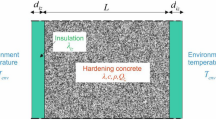Abstract
A range of seven test methods was used to asses the effectiveness of curing on C30 and C50 Portland cement concretes. Curing was by formwork retention, wrapping in wet hessian or wrapping in polythene for periods of between one and seven days. Specimens from each mix were also subjected to both air and water storage.
Electrical resistance measurement and water absorption by immersion were ineffective in distinguishing the effects of different curing regimes. Air permeability, water sorptivity, surface pull-off strength, mercury intrusion porosimetry and accelerated carbonation were able to show distinct differences between air storage and immersion in water. These tests were generally ineffective in distinguishing trends for practical curing techniques.
Résumé
Sept méthodes d’essai ont été employées pour évaleur leur efficacité dans la cure, des bétons de ciment Portland C30 et C50. Les cures ont été effectuées au moyen de coffrages de rétention, ou par enveloppement en toile de chanvre mouillé ou en polythène, pour des périodes allant de un à sept jours. Des échantillons de chaque mélange ont également été soumis à l’air et conservés dans l’eau.
Les mesures de résistance électrique et d’absorption de l’eau par immersion n’ont pas été efficaces pour différencier les effets des différents méthodes de cure. Par contre, les mesures de perméabilité de l’air, de sorptivité de l’eau, de résistance à tirage superficielle, de porosimétrie de pénétration de mercure et de carbonatation accélérée ont permis de montrer des différences marquées entre la conservation à l’air et à l’eau. En général, ces essais ne se sont pas montrés efficaces pour déterminer des tendances applicables aux techniques de cure dans la pratique.
Similar content being viewed by others
References
Parrott, L.J., ‘Moisture profiles in drying concrete’,Adv. Conc. Res. 1 (3) (1988) 164–170.
Marsh, B.K. and Ali, M.A., ‘Assessment of the effectiveness of curing on the durability of reinforced concrete’, A.C.I. SP-145, Nice, France, 1994, 1161–1176.
Basheer, P. A. M., Long, A. E. and Montgomery, F. R., ‘The Autoclam for measuring the surface absorption and permeability of concrete on site’, V. M. Malhotra (Ed.), Proc. CANMET/ACI International conference on advances in concrete technology, Athens, Greece, 11–13 May, 1992, 107–132.
Long, A.E., Murray, A.M., ‘The pull-off partially destructive test for concrete, In-situ/Non-destructive testing of concrete’, A.C.I. SP-82, Detroit, 1984, 327–350.
McCarter, W.J., Ezirim, H. and Emmerson, M., ‘Absorption of water and chloride into concrete’,Mag. Conc. Res. 44 (158) (March 1992) 31–37.
Winslow, D.N. and Diamond, S., ‘An M.I.P. study of evolution of porosity in Portland cement’,Journal of Mater. 5 (3) (1970) 564–585.
Author information
Authors and Affiliations
Additional information
Editorial note Dr. B.K. Marsh and M.A. Ali work at the Building Research Establishment, U.K., which is a RILEM Titula Member.
Rights and permissions
About this article
Cite this article
Nolan, É., Ali, M.A., Basheer, P.A.M. et al. Testing the effectiveness of commonly-used site curing regimes. Mat. Struct. 30, 53–60 (1997). https://doi.org/10.1007/BF02498740
Issue Date:
DOI: https://doi.org/10.1007/BF02498740




